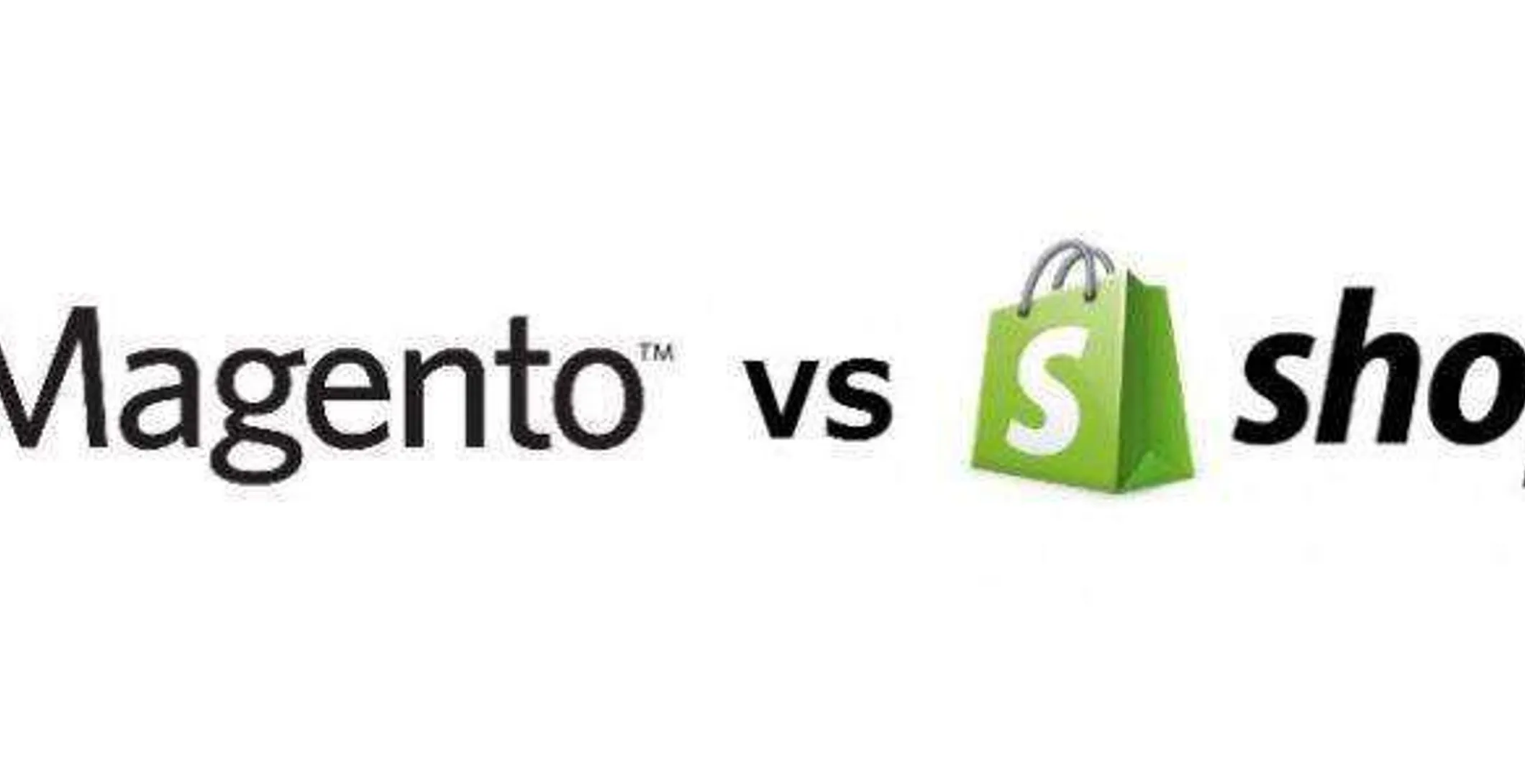Shopify and Magento are both economically huge e-commerce platforms and two of the most popular amongst businesses, new and old. Magento is the most popular e-commerce platform across the board with 14% of the top million sites, they sport names like Nike, Rosetta Stone, Ghiradelli and Oylmpus. But Shopify is rapidly gaining popularity too, and are currently sitting at 6%, with client names like the Los Angeles Lakers Store and Telsa. The two platforms are widely considered to be the leaders in E-Commerce, so we decided to deconstruct them for you to see how they compare.
Basic Structure
Magento and Shopify are built using very different code. Magento uses PHP, it is open source code and can be changed and modified by a developer. This means your template code can be modified to suit your needs. You will need someone who understands PHP to make alterations for you.
Shopify is built with a kind of code called Liquid, it can be changed for tuning the design and how the shop will look in public side. In some ways this can be considered great for new startups and small businesses because the themes are all laid out and ready to use and generally don’t require the assistance of a web developer. However, the moment you want to start customizing your website, adding more products or expanding and evolving it – Magento takes the lead.
So Shopify is a good choice for smaller, simple sites, and Magento is a better choice for bigger, more complicated stores with specific needs or those wanting personalised functionality. But basic structure is not the only factor that has to be considered. Lets take a look at a few more.
Store Functionality, Themes and Templates

Both Magento and Shopify offer powerful store functionalities. They have their own themes to choose from, both offering a wide range. All of these offerings require ongoing maintenance to keep them up to date.
Your Products
Magento’s community based model (the basic model) allows an unlimited number of inventory items. Shopify’s starter plan (their basic model) allows up to 25 items. More than that and you must upgrade to a more expensive model.
Both Magento and Shopify offer a variety of paid themes, too, but Shopify’s premium themes start at around $80 whereas Magento, with their huge free platform and open source code, starts their premium options at just $1! All of the themes are responsive across a variety of platforms, taking your e-commerce site from desktop to tablet to mobile.
One of the most notable factors when it comes to themes and templates is the effect of the source code. Shopify’s Liquid code means that new themes, templates and plugins need to be developed by one of their own experts and this can be costly – hence their more expensive premium options.
However, Magento is open source and written in PHP. This means that there are thousands of people around the globe who can build and innovate new plugins for Magento. This means the evolution of the platform has advanced further than Shopify’s, and there are thousands of different options available for free or a for a very small fee.
Coupons and Codes

Shopify doesn’t allow for the use of coupons or discount codes on their starter option. To use this feature with Shopify you must first upgrade to a paid option. Magento does allow for the use of discount codes, even on their free option, and offers a code creation and calculation functionality.
Payment Gateways
Both Platforms offer a variety of gateway options. Shopify supports more different options in house, but Magento allows for more gateways to be added through third-party add-ons. The end result being much the same, there are multiple options available for both.
Shipping Calculations
Both Magento and Shopify offer highly effective functionalities for working out shipping charges within the payment gateway. This is important to customers who want a full understanding of their costs upfront.
Add Ons and Apps
Magento has the advantage as far as add ons and Apps are concerned, with more than 5000 apps and add ons available to their subscribers. Shopify has over 100 apps and add ons of their own, but Magento has the advantage thanks to the open source nature of the platform. Both Magento and Shopify offer paid options and free options, depending on what you want to achieve and what you are willing to invest.
Bi-lingual functionality
Magento offers a variety of built in multi-lingual support capabilities. This means you can access markets across the globe and appeal to a much larger demographic.
To use multiple languages across Shopify you have to buy paid third-party apps specifically designed for the purpose. They do exist, they are just not free.
Search Engine Optimization (SEO)
Magento and Shopify are both very dedicated to ensuring your online store is found by both existing customers and new shoppers. The two platforms score very closely on the SEO capabilities they offer. An important part of SEO for many websites is maintaining a blog that relates to your product or industry. Shopify integrates a blog into their main website, and Magento (being the open source, user driven platform that it is) offers this function with a free plug in. The two score neck on neck in this category.
Hosting Costs
Hosting is important because it effects your website speed, your storage abilities and the number of products you can ultimately load onto your site.
Magento is self hosted, which means you will probably have to pay a hosting company to host your website. The nice thing is that with Magento you can choose exactly the hosting solution that you need and want. But i can vary very much about your needs, site usage and the scope of your business. As Magento is more oriented to enterprise than just regular eCommerce business.
Shopify is hosted by the holding company, so users must use their prescribed hosting option.
Cost Implications
You have to spend money to make money, we know this. But it is worthwhile to take a look at what the hidden and repeated costs are, because they can add up quickly and could become a costly experience, which is not something you need when setting up a new business.
Shopify uses the SAAS system (Software-as-a-service). Which means that users pay a monthly fee to access the platform. Their costs range from the basic option which comes in at $29 a month for the basic option, to the most expensive option which is around $179 a month, and the pro option sitting in the middle at $79.
The more Shopify customers pay, the greater their functionality is. The more expensive your Shopify plan is the more features you will have access to, such as recovery of abandoned carts, advanced reporting and gift cards.
Magento offers these features for a much lower rate per year, or for free. Many of their functions are available with the free option, and those items that do costs a little more are usually worth every cent, because they are so well developed.
On top of their subscription fees, Shopify ensures that they make a cut every time you make a purchase by charging transaction fees of around 5% on every transaction. The only way to avoid these fees is to use Shopify’s direct payment gateway.
Platform costs

Magento’s community edition can be downloaded free. This a good option for small businesses and developers. They also offer the enterprise solution – the cost of this varies depending on what you choose to do with your store.
Shopify does not offer a free option, and their models are rigidly priced.
Brand Equity
Your brand is your business, and it should be carried through to every aspect of your business, communicating your essence to your customers.
Magento allows the business owner complete control over every aspect of their website. It can be altered to suit your exact brand and fit seamlessly with your corporate identity. They have a much wider range of front end features to choose from for your store experience. It also allows you to operate several stores from the same control panel.
Shopify offers fewer front end features. It also, unfortunately, is a lot more rigid and less adaptable. Aside from the changing of a few fonts and colours, themes within Shopify can’t be adapted or altered.
Shopify vs Magento
At the end of the day your choice of platform comes down to what you want to achieve with your e-commerce site. If you are looking to set up a small store that’s ready to use and you don’t mind paying a monthly subscription and not being able to customise – then Shopify maybe be for you.
If you want to have a more flexible website, you need to personalise it to suit your brand and you don’t want to pay excessive subscription fees, then you should definitely consider Magento.




